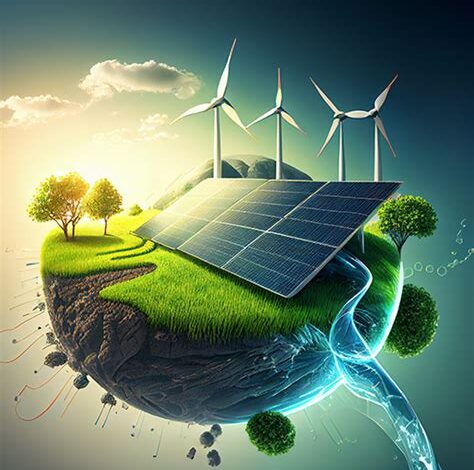The Use of Technology in Sustainable Energy Solutions

Discover the latest advancements in renewable energy like solar and wind, smart grid technology, and energy efficiency innovations. Stay informed and sustainable.In today’s world, the use of technology has revolutionized the way we harness and utilize sustainable energy solutions. With a growing focus on addressing climate change and reducing our carbon footprint, the integration of renewable energy sources has become essential. From solar and wind power to advancements in energy storage and smart grid technology, the possibilities for creating a more sustainable future are endless.
In this blog post, we will explore the impact of technology on sustainable energy solutions, focusing on the latest developments in renewable energy sources, such as solar and wind power. We will also delve into the technological advancements that have propelled these sources to the forefront of the energy industry, as well as the innovations in energy storage and smart grid solutions that are shaping the future of sustainable energy. Join us as we delve into the ways in which technology is driving progress towards a more energy-efficient and sustainable world.
Renewable Energy Sources
In today’s world, the focus on renewable energy sources has become increasingly important as we strive to reduce our reliance on fossil fuels and decrease our impact on the environment. One of the most well-known and widely used renewable energy sources is solar power, which harnesses the energy of the sun to generate electricity. This technology has advanced significantly in recent years, making it more accessible and efficient for both residential and commercial use. Another increasingly popular renewable energy source is wind energy, which utilizes the power of the wind to generate electricity. With advancements in wind energy technology, wind turbines have become more efficient and cost-effective, making wind farms a viable and sustainable energy solution.
In addition to solar and wind energy, other renewable energy sources include hydroelectric power, geothermal energy, and biomass energy. Hydroelectric power harnesses the energy of flowing water to generate electricity, while geothermal energy taps into the heat of the earth to produce power. Biomass energy, on the other hand, utilizes organic materials such as wood and agricultural waste to create energy. These renewable energy sources offer alternatives to traditional fossil fuels, helping to reduce greenhouse gas emissions and combat climate change.
As the demand for sustainable energy solutions continues to grow, the development of smart grid and energy storage technologies has become increasingly important. Smart grid systems enable efficient and effective energy distribution, while energy storage solutions such as batteries and capacitors ensure that renewable energy can be stored and used when needed. These advancements in technology are crucial for the widespread adoption of renewable energy sources and the transition towards a more sustainable and environmentally friendly energy infrastructure.
Technology Advancements in Solar Power
With the increasing demand for sustainable and renewable energy sources, technology has played a crucial role in advancing solar power solutions. One of the major technological advancements in solar power is the development of more efficient and cost-effective solar panels. These panels are now designed to capture and convert a higher percentage of sunlight into electricity, making solar power a more viable option for both residential and commercial use.
Another key innovation in solar power technology is the integration of smart solar systems. These systems are equipped with advanced monitoring and control features, allowing users to optimize energy production and consumption. In addition, the integration of energy storage solutions such as batteries has further enhanced the reliability and flexibility of solar power systems, enabling users to store excess energy for use during times of low sunlight or high energy demand.
Furthermore, advancements in solar power technology have also led to the development of solar tracking systems. These systems are designed to automatically adjust the position of solar panels throughout the day to maximize sunlight exposure, thereby increasing energy production efficiency. Additionally, the integration of Internet of Things (IoT) technology has enabled real-time monitoring and management of solar power systems, allowing for predictive maintenance and improved overall performance.
Innovations in Wind Energy Technology
Wind energy technology has seen remarkable advancements in recent years, with innovations contributing to the increased efficiency and accessibility of wind power as a sustainable energy source. One of the key innovations in wind energy technology is the development of larger and more efficient wind turbines. These modern turbines are designed to capture more energy from the wind, generating higher power outputs and reducing the cost of producing electricity from wind. The use of smart technology in wind turbines has also become prevalent, with sensors and control systems optimizing the performance of the turbines, resulting in improved reliability and operational flexibility.
Furthermore, advancements in materials and manufacturing processes have led to the development of lighter, more durable turbine blades, enhancing the overall reliability and longevity of wind turbines. The integration of data analytics and predictive maintenance techniques has also played a significant role in improving the operational efficiency of wind farms, minimizing downtime and maintenance costs. Moreover, the deployment of advanced weather forecasting technology has enabled wind farm operators to accurately predict wind patterns and optimize the positioning of turbines, maximizing energy production.
In addition to technological innovations in turbine design, the advancement of grid integration solutions has been a crucial aspect of wind energy technology. The integration of energy storage systems and smart grid technologies has enhanced the flexibility and reliability of wind power integration into the electrical grid. This has facilitated the seamless integration of wind energy with conventional power sources, addressing the intermittency of wind power and ensuring a stable supply of electricity to consumers.
Smart Grid and Energy Storage Solutions
Sustainable energy solutions have become increasingly important in our efforts to combat climate change and reduce our reliance on nonrenewable resources. One area of focus within this field is the development and implementation of smart grid and energy storage solutions. These technologies play a crucial role in optimizing energy distribution, managing peak demand, and integrating renewable energy sources into the grid.
Smart grid technology refers to the use of digital communication and control systems to improve the efficiency, reliability, and sustainability of the electric grid. It enables real-time monitoring and analysis of energy consumption patterns, allowing for more effective management of power distribution. By incorporating advanced sensors, meters, and automation tools, smart grids can better respond to changes in demand and supply, leading to a more resilient and adaptable energy system.
Energy storage solutions are another key component of sustainable energy infrastructure. These technologies allow for the capture and storage of excess energy generated from renewable sources, such as solar and wind power. By storing this energy for later use, energy storage systems help to mitigate the intermittent nature of renewables and ensure a more consistent and reliable energy supply. Additionally, energy storage can alleviate strain on the grid during peak demand periods, reducing the need for additional fossil fuel-based power plants.
Impact of Technology on Energy Efficiency
Technology plays a crucial role in improving the efficiency of energy usage and reducing environmental impact. The development of smart home devices and energy-efficient appliances has made it easier for consumers to monitor and control their energy usage, ultimately leading to greater conservation and lower energy bills. These advancements have allowed for more sustainable and eco-friendly living, contributing to a healthier planet for future generations.
Furthermore, the integration of smart grid technology has revolutionized the way energy is managed and distributed. By utilizing digital communication and automation, smart grids are able to optimize energy flow and reduce waste, resulting in increased efficiency and reliability of energy delivery. This not only benefits consumers but also the environment by minimizing carbon emissions and promoting cleaner energy sources.
Additionally, the rise of energy storage solutions such as lithium-ion batteries has paved the way for greater integration of renewable energy sources into the grid. As renewable energy like solar and wind power become more widely utilized, efficient energy storage becomes even more critical. With advancements in battery technology, excess energy can be stored and utilized during peak demand, reducing the need for fossil fuels and further improving energy efficiency.





